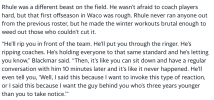- Messages
- 19,993
- Likes
- 84,360
18 players have to go by fall who doesn't make the cut?
(Bolded players have used their redshirts.)
| Pos. | Fr. | RFr. | So. | Jr. | Sr. |
|---|---|---|---|---|---|
| QB (6) | Richard Torres | Heinrich Haarberg Chubba Purdy | Logan Smothers Jeff Sims | Casey Thompson | |
| RB (6) | Kwinten Ives | Emmett Johnson Ajay Allen | Gabe Ervin Jr. | Rahmir Johnson | Anthony Grant |
| WR (16) | Malachi Coleman Jaidyn Doss Brice Turner Jaylen Lloyd Jeremiah Charles Demitrius Bell | Janiran Bonner Victor Jones Jr. | Shawn Hardy II Zavier Betts | Alante Brown Tommi Hill Isaiah Garcia-Castaneda | Marcus Washington Josh Fleeks Billy Kemp IV |
| TE (8) | Ismael Smith Flores | Chase Androff Brodie Tagaloa | James Carnie Thomas Fidone AJ Rollins Arik Gilbert | Chris Hickman | |
| OL (15) | Gunnar Gottula Brock Knutson Sam Sledge Mason Goldman Jason Maciejczak | Justin Jenkins Jacob Hood | Henry Lutovsky Teddy Prochazka | Bryce Benhart Turner Corcoran Ethan Piper Nouredin Nouili Ben Scott | Hunter Anthony |
| DL (9) | Vincent Carroll-Jackson Riley Van Poppel Cameron Lenhardt Sua Lefotu | Ru’Quan Buckley Elijah Jeudy | Nash Hutmacher Ty Robinson | Stephon Wynn Jr. | |
| LB (8) | Eric Fields Dylan Rogers | Seth Malcom Randolph Kpai Mikai Gbayor | Nick Henrich Garrett Snodgrass | Luke Reimer | |
| EDGE (8) | Maverick Noonan Princewill Umanmielen | Jake Appleget | Blaise Gunnerson Jimari Butler Chief Borders Kai Wallin | MJ Sherman | |
| NICK (3) | Gage Stenger | Isaac Gifford Javin Wright | |||
| CB (11) | Dwight Bootle II Syncere Safeeullah Ethan Nation D’Andre Barnes | Tamon Lynum Malcolm Hartzog | Javier Morton | Omar Brown Braxton Clark Tyreke Johnson Quinton Newsome | |
| S (9) | Rahmir Stewart | Jalil Martin | Koby Bretz Kaine Williams Corey Collier | Myles Farmer Marques Buford Noa Pola-Gates DeShon Singleton | |
| ST (4) | Tristan Alvano | Timmy Bleekrode Brian Buschini | Marco Ortiz | ||
| Class Total | 27 | 12 | 25 | 26 | 13 |
| Total | 27/85 | 39/85 | 64/85 | 90/85 | 103/85 |


